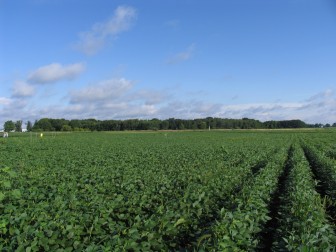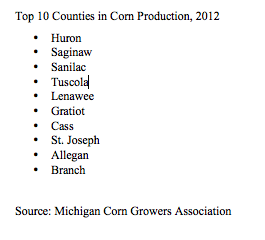LANSING – More crops were planted in the northern Midwest this year than last year, including Michigan, according to a federal report.

Photo: Organic soybean farm. Credit J.E. Doll, Michigan State University.
The U.S. Department of Agriculture (USDA) report says Michigan farmers planted 300,000 more acres of principal crops in 2014 compared to 2013.
One reason may be that warmer temperatures are allowing for a longer growing season, said Jim Byrum, president of the Michigan Agri- Business Association.
With frost starting later in the year, crops have more time to mature, he said. And higher temperatures are prompting crop production to expand northward.
You can expect that trend to continue, Byrum said.
“As that moves north, as it has steadily over the past few decades, farmers will move production into areas that historically haven’t been able to support that kind of production,” he said.

Table via Michigan Corn Growers Association
For example, soybean production has moved further north, as in Isabella County north of Ithaca, said Paul Gross, a Michigan State University Extension crops and agriculture educator.
Farmers are also planting more acreage in Cheboygan and Alpena counties.
The amount of land planted nationwide for soybeans set a record of 84.8 million acres, 11 percent higher than in 2013.
That could result in 84.1 million acres harvested, which is also 11 percent higher than last year. USDA said. The amount harvested differs from the amount planted because crops can fail for weather, disease and other reasons.
Michigan also set a record in soybean acreage planted this year. The top three counties for soybean acreage are Sanilac, Lenawee and Saginaw.
While soybean and wheat acreage has increased, corn acreage dropped 4 percent from last year nationally. Federal officials estimate that 91.6 million acres were planted with corn nationally.
In Michigan, Lenawee, St. Joseph and Allegan counties rank among the top 10 in corn production.
Although weather is a major factor, price also plays a role.
It’s economically driven, said Lance Honig, chief of the Crops Branch for the USDA National Agricultural Statistics Service. That’s why corn acreage is decreasing.
“It’s just an economic situation where soybean prices are much more favorable to corn prices,” Honig said.
The number of acres planted last year was lower than what it could have been, Honig said. About 10 million acres didn’t get planted because of the weather.
Better weather this year allowed farmers to plant more acres, he said.
But this year’s situation is no guarantee for the future.
With the cold winter and the cooler summer, crops in the northern regions may not reach maturity, Gross said.
“We had the cool spring followed by a relatively cool summer,” he said. “If we have an early fall some of those northern, later planted, fields could be disasters.
“We’ve been able to move some of those crops further north but there’s going to be years that might not work so well,” he said. “This might be one of them.”
This increase may not happen year after year but it does allow a huge opportunity for Michigan farmers to increase production, Gross said.
“We were able to produce more things on more acres in some northern Michigan lands that are primarily grasslands, acres that were farmed at one time that aren’t anymore,” he said.
As farming expands on these lands, there is the opportunity to plant more crops and create more farm jobs, Gross said.
Byrum agreed, saying, “Overall Michigan agriculture will continue to grow and thrive.”
Lacee Shepherd writes for Great Lakes Echo.